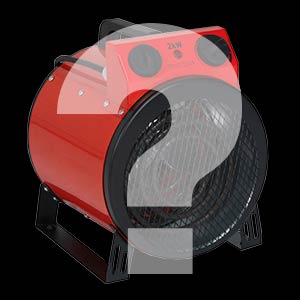How big a heater do I need for my workshop?
We hear this question a lot at ESE Direct, we have customers with a wide variety of spaces, from voluminous warehouses to cosy workshops, but they all want to know the same thing; What size or power heater do I need? Of course, physical size and heat provided are not inextricably linked, so the best way to compare heaters is by the power ratings, although it can be worth bearing in mind that a physically larger heater with a fan is going to move a lot more air than a small one, so you may feel the benefit of it quicker.
How many will I need?
Of course, sometime the answer is not simple; putting in a single large heater could well end up with uneven heat distribution, leaving some areas of the workspace as cold as before, whilst other workers sweat away in tropical temperatures. With this in mind, we'll look at how to calculate the total wattage or BTU needed for a space, this can then either be supplied by one large heater, or multiple smaller ones. Another consideration will be the availability of power, especially as many of the bigger heaters require a five pin connection, rather than the standard 3 pin wall sockets. Space and convenience can also play a part, as finding floor space for multiple heaters in areas where they won’t block access or be in the way, can be difficult.
What is your room like?
Do you have multiple large windows? Are the ceilings high? Questions like this can make a huge difference to the heating of a room. Although large windows will let out heat, it may be that this is mitigated by the extra warmth you get from the sun shining through them. Also, floor covering can make a difference to the feel of a room, if you are trying to heat a large warehouse or factory, concrete flooring will make it feel much colder, so this could be countered with carpet tiles or rubber matting.
How are heaters rated?
There are two main measurements given for heaters, these are wattage and BTU. As you may remember from school, a watt is a unit of power defined as one joule per second and is a measurement of energy transfer; therefore a 1000W heater is able to transfer one thousand joules of energy every second.
BTU, on the other hand, is a more traditional measurement and stands for British Thermal Unit. This is defined as the amount of heat required to raise the temperature of a pound of water by one degree Fahrenheit and heaters tend to be rated in BTU's per hour. As a rough guide, one BTU can be thought of as the heat given out by the burning of a single match.
How big is your room?
Next, it is time to measure the room you are trying to heat. If this is a simple rectangle, it is purely a matter of measuring the width and length and multiplying them together, if your room is a more irregular shape but can be divided into various rectangles, calculate these areas separately and then add them together. If you are trying to heat an area that has curves and circular rooms, be prepared to get your calculator out and dust of your familiarity with PI.
The calculation
Depending on whether you are measuring in feet or metres, there are two calculations you need to do next. We can estimate that a square foot of room will require 10 watts, since a square metre is equal to 0.09 square meters, each square metre will require 111 watts. Converting Watts in BTU is simply a matter of multiplying by 3.41.
SQUARE FEET
Size of room x 10 = wattage required
Wattage required x 3.41 = BTUs required
Example
If we had a room that was 60' x 80', this would be 2,400 sqft
2400 x 10 = 24,000 Watts.
24,000 x 3.41 = 81,840 BTU’s per hour
You could choose 2 x 15kW Heavy-duty heaters
SQUARE METRES
Size of room x 111 = wattage required
Wattage required x 3.41 = BTU's required
Example
If we had a room that was 3m x 5m, this would be 15m²
15 x 111 = 1665 Watts.
1665 x 3.41 = 5678 BTU's per hour
You could choose a 2kW fan heater.
These calculations are a good start to figuring out the size of heater you need, but it is worth bearing in mind that these are assuming a ceiling height of around 8ft or 2.5m. Significantly higher ceilings will mean a much bigger volume of air to heat, so the wattage required will increase accordingly.

Author Bio - Debs
Digital marketer, social media, content writer, musician, sloth-lover, tea-drinker.






